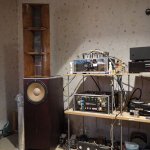That wouldn't by chance be included in the Linear Audio USB stick? I have tried to find it in the directory but failed.Electrostatic Loudspeakers, Peter J. Baxandall; Chapter 3 in Loudspeaker and Headphone Handbook, John Borwick, Editor.
Jan
The last time I talked to this guy was somewhere in 2014, I remember he said that several resins are used in the manufacture of these stators and he experimented a lot by mixing these resins, for this he even made a mechanized “hand” to continuously mix with it for several days: ).Interesting
I would love to see how, i still can't figure out the way they build the conductive part of their stators.
As i understand it they use the composite resin as part of the whole capacitor, that it has high dielectric constant.
The resulting composite had high-resistance conductivity. In the dark, the stator glowed with a barely noticeable blue color.
I made a mistake when I previously wrote about holes (perforations) in the form of tubes, I found a photo of it on an old computer, its stators and holes are in the form of horizontal holes, and also in the photo is its amplifier (direct drive):
Attachments
No its not in the stick, sorry.That wouldn't by chance be included in the Linear Audio USB stick? I have tried to find it in the directory but failed.
Jan
The last time I talked to this guy was somewhere in 2014, I remember he said that several resins are used in the manufacture of these stators and he experimented a lot by mixing these resins, for this he even made a mechanized “hand” to continuously mix with it for several days: ).
The resulting composite had high-resistance conductivity. In the dark, the stator glowed with a barely noticeable blue color.
I made a mistake when I previously wrote about holes (perforations) in the form of tubes, I found a photo of it on an old computer, its stators and holes are in the form of horizontal holes, and also in the photo is its amplifier (direct drive):
Nice!
Thanks for digging up the photo's, inspiring build



